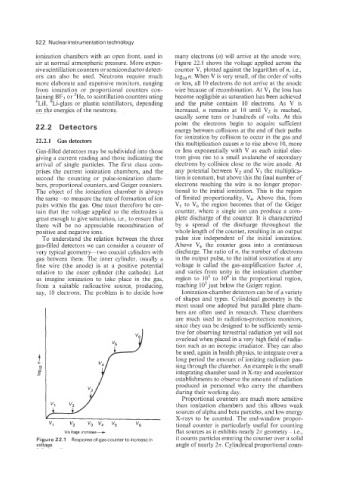Page 539 - Instrumentation Reference Book 3E
P. 539
522 Nuclear instrumentation technology
ionization chambers with an open front, used in many electrons (n) will arrive at the anode wire.
air at normal atmospheric pressure. More expen- Figure 22.1 shows the voltage applied across the
sive scintillation counters or semiconductor detect- counter V, plotted against the logarithm of n, Le.,
ors can also be used. Neutrons require much logl, n. When V is very small, of the order of volts
more elaborate and expensive monitors, ranging or less, all 10 electrons do not arrive at the anode
from ionization or proportional counters con- wire because of recombination. At VI the loss has
tainin BF3 or 3He, to scintillation counters using become negligible as saturation has been achieved
6. %.
LiI: Li-glass or plastic scintillators, depending
and the pulse contains 10 electrons. As V is
on the energies of the neutrons. increased, n remains at 10 until Vz is reached,
usually some tens or hundreds of volts. At this
point the electrons begin to acquire sufficient
22.2 Detectors energy between collisions at the end of their paths
for ionization by collision to occur in the gas and
22.2.1 Gas detectors this multiplication causes n to rise above 10, more
Gas-filled detectors may be subdivided into those or less exponentially with V as each initial elec-
giving a current reading and those indicating the tron gives rise to a small avalanche of secondary
arrival of single particles. The first class com- electrons by collision close to the wire anode. At
prises the current ionization chambers, and the any potential between V2 and V3 the multiplica-
second the counting or pulse-ionization cham- tion is constant, but above this the final number of
bers, proportional counters, and Geiger counters. electrons reaching the wire is no longer propor-
The object of the ionization chamber is always tional to the initial ionization. This is the region
the same-to measure the rate of formation of ion of limited proportionality, V4. Above this, from
pairs within the gas. One must therefore be cer- V5 to v6 the region becomes that of the Geiger
tain that the voltage applied to the electrodes is counter, where a single ion can produce a com-
great enough to give saturation, i.e., to ensure that plete discharge of the counter. It is characterized
there will be no appreciable recombination of by a spread of the discharge throughout the
positive and negative ions. whole length of the counter, resulting in an output
To understand the relation between the three pulse size independent of the initial ionization.
gas-filled detectors we can consider a counter of Above V6 the counter goes into a continuous
very typical geometry-two coaxial cylinders with discharge. The ratio of n, the number of electrons
gas between them. The inner cylinder, usually a in the output pulse, to the initial ionization at any
fine wire (the anode) is at a positive potential voltage is called the gas-amplification factor A,
relative to the outer cylinder (the cathode). Let and varies from unity in the ionization chamber
us imagine ionization to take place in the gas, region to lo3 to lo4 in the proportional region,
from a suitable radioactive source, producing, reaching 10’just below the Geiger region.
say, 10 electrons. The problem is to decide how Ionization-chamber detectors can be of a variety
of shapes and types. Cylindrical geometry is the
most usual one adopted but parallel plate cham-
bers are often used in research. These chambers
are much used in radiation-protection monitors,
since they can be designed to be sufficiently sensi-
tive for observing terrestrial radiation yet will not
overload when placed in a very high field of radia-
tion such as an isotopic irradiator. They can also
be used, again in health physics, to integrate over a
long period the amount of ionizing radiation pas-
sing through the chamber. An example is the small
integrating chamber used in X-ray and accelerator
establishments to observe the amount of radiation
produced in personnel who carry the chambers
during their working day.
Proportional counters are much more sensitive
than ionization chambers and this allows weak
sources of alpha and beta particles, and low energy
X-rays to be counted. The end-window propor-
tional counter is particularly useful for counting
Voltage increase- flat sources as it exhibits nearly 2.ii geometry ~ i.e.,
Figure 22 .I Response of gas counter to increase in it counts particles entering the counter over a solid
voltage. angle of nearly 2%. Cylindrical proportional coun-

